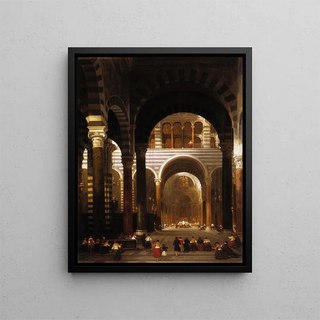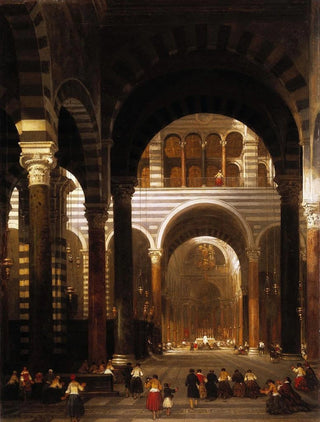Art print | Interior of the Pisa Cathedral - David Roberts


View from behind

Frame (optional)
In the vast panorama of 19th-century art, David Roberts' work stands out for its ability to capture the very essence of the places he depicts. The art print Interior of the Pisa Cathedral - David Roberts transports us to a space where light plays with shadows, revealing the majesty of an iconic building. This painting is much more than a simple representation; it is an invitation to explore the depths of Gothic architecture and to feel the spiritual atmosphere emanating from this sacred place. Through his artistic gaze, Roberts manages to evoke a palpable emotion, immersing us in a visual journey to the heart of Italy.
Style and uniqueness of the work
Roberts' work is characterized by striking realism, a precision in details that demonstrates a deep respect for architecture and history. In Interior of the Pisa Cathedral, each column, each vault, and each decorative element is rendered with meticulous care, inviting the viewer to contemplate the grandeur of the edifice. The play of light, subtly orchestrated, enhances the depth of the composition and creates an almost mystical atmosphere. Using a palette of soft and warm colors, Roberts succeeds in translating the harmony of this sacred space, while highlighting the architectural details that make the cathedral famous. This painting stands out for its ability to merge the architectural landscape with an almost spiritual dimension, offering a unique visual experience.
The artist and his influence
David Roberts, born in Scotland in 1796, is considered one of the pioneers of Romantic landscape art. His work is marked by travels across Europe and the Middle East, where he immerses himself in the culture and architecture of the places he visits. His style, influenced by Romanticism, is fueled by a quest for beauty and a fascination with historic landscapes. The Pisa Cathedral, with its rich heritage and iconic architecture, finds a particular resonance in Roberts' work. By capturing the majesty of this edifice, he contributes to the preservation of

Matte finish

View from behind

Frame (optional)
In the vast panorama of 19th-century art, David Roberts' work stands out for its ability to capture the very essence of the places he depicts. The art print Interior of the Pisa Cathedral - David Roberts transports us to a space where light plays with shadows, revealing the majesty of an iconic building. This painting is much more than a simple representation; it is an invitation to explore the depths of Gothic architecture and to feel the spiritual atmosphere emanating from this sacred place. Through his artistic gaze, Roberts manages to evoke a palpable emotion, immersing us in a visual journey to the heart of Italy.
Style and uniqueness of the work
Roberts' work is characterized by striking realism, a precision in details that demonstrates a deep respect for architecture and history. In Interior of the Pisa Cathedral, each column, each vault, and each decorative element is rendered with meticulous care, inviting the viewer to contemplate the grandeur of the edifice. The play of light, subtly orchestrated, enhances the depth of the composition and creates an almost mystical atmosphere. Using a palette of soft and warm colors, Roberts succeeds in translating the harmony of this sacred space, while highlighting the architectural details that make the cathedral famous. This painting stands out for its ability to merge the architectural landscape with an almost spiritual dimension, offering a unique visual experience.
The artist and his influence
David Roberts, born in Scotland in 1796, is considered one of the pioneers of Romantic landscape art. His work is marked by travels across Europe and the Middle East, where he immerses himself in the culture and architecture of the places he visits. His style, influenced by Romanticism, is fueled by a quest for beauty and a fascination with historic landscapes. The Pisa Cathedral, with its rich heritage and iconic architecture, finds a particular resonance in Roberts' work. By capturing the majesty of this edifice, he contributes to the preservation of






